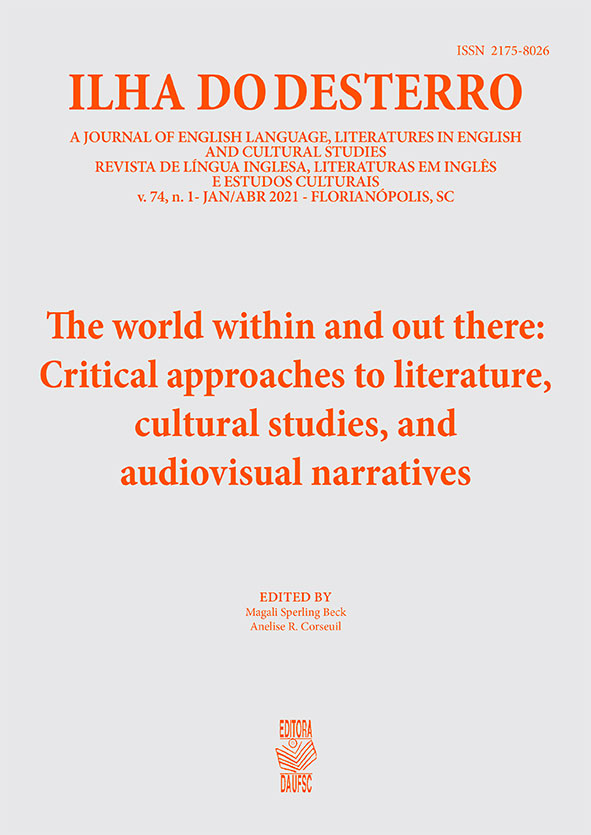Unveiling the Contemporary in Virginia Woolf
DOI:
https://doi.org/10.5007/2175-8026.2021.e74632Abstract
This article aims to discuss Virginia Woolf’s critical appraisal of the contemporariness of her contemporaries’ production, focusing on her 1923 essay “How It Strikes a Contemporary”. To that end, it contextualizes the publication of The Common Reader – First Series (1925) so as to problematize its conversational quality as a philosophical principle inherent to Woolf’s oeuvre (Pinho 2020). A comparison is also drawn between Woolf’s “How It Strikes a Contemporary” and Giorgio Agamben’s “What Is the Contemporary?” (2009) in order to shed light on the intersections between contemporary philosophy and the philosophical questions we find in Woolf’s writing.References
Agamben, Giorgio. “What is the Contemporary?” What Is an Apparatus? and Other
Essays. Stanford University Press, 2009, pp. 39-54.
Agamben, Giorgio. “Philosophical Archaeology.” The Signature of All Things: on
Method. Zane Books, 2009, pp. 9-34
Agamben, Giorgio. “The Logic of Sovereignty.” Homo Sacer – Sovereign Power and
Bare Life, Stanford University Press, 1998, pp. 15-44.
Braidotti, Rosi. “Intensive Genre and the Demise of Gender”. Nomadic Theory, The
Portable Rosi Braidotti, Columbia University Press, 2011, pp. 150-169.
Briggs, Julia. “A Woman Connects”. An Inner Life, Harcourt, 2005, pp. 109-129.
Fry, Roger. Vision and Design. Dover Publications, 2011.
Goldman, Jane. Modernism, 1910-1945, Image to Apocalypse. Palgrave MacMillan,
Hite, Molly. Woolf ’s Ambiguities: Tonal Modernism, Narrative Strategy, Feminist
Precursors. Cornell University Press, 2017.
Lee, Hermione. “Virginia Woolf ’s Essays.” The Cambridge Companion to Virginia
Woolf, edited by Susan Sellers, Cambridge University Press, 2010, pp. 89-106.
McNeillie, Andrew. “Introduction.” The Common Reader – Volume I, written by
Virginia Woolf, Vintage, 2003, pp. vii-xii.
Pinho, Davi. “A conversa como um ‘método’ filosófico em Virginia Woolf.” Conversas
com Virginia Woolf, edited by Davi Pinho, Maria Oliveira and Nícea Nogueira,
Ape’ku, 2020, pp. 11-31.
Pinho, Davi. Imagens do feminino na obra e na vida de Virginia Woolf. Appris, 2015.
Woolf, Virginia. A Room of One’s Own. Wordsworth Classics, 2012.
Woolf, Virginia. “A Sketch of the Past.” Moments of Being, Harcourt Inc, 1985, pp.
-159.
Woolf, Virginia. “Character in Fiction.” Selected Essays, Oxford University Press,
, pp. 37-54.
Woolf, Virginia. “Craftsmanship.” Selected Essays, Oxford Classics, 2009, pp. 85-91.
Woolf, Virginia. “How it Strikes a Contemporary”. Selected Essays, Oxford Classics,
, pp. 23-31.
Woolf, Virginia. The Diary of Virginia Woolf, edited by Anne Olivier Bell, Penguin
Books, 1979-1985.
Woolf, Virginia. “The Modern Essay”. Selected Essays, Oxford Classics, 2009, pp. 13-
Woolf, Virginia. The Waves. Oxford Classics, 2015.
Downloads
Published
Issue
Section
License
Copyright (c) 2020 Patricia Fagundes

This work is licensed under a Creative Commons Attribution 4.0 International License.

This work is licensed under a Creative Commons Attribution 4.0 International License.



